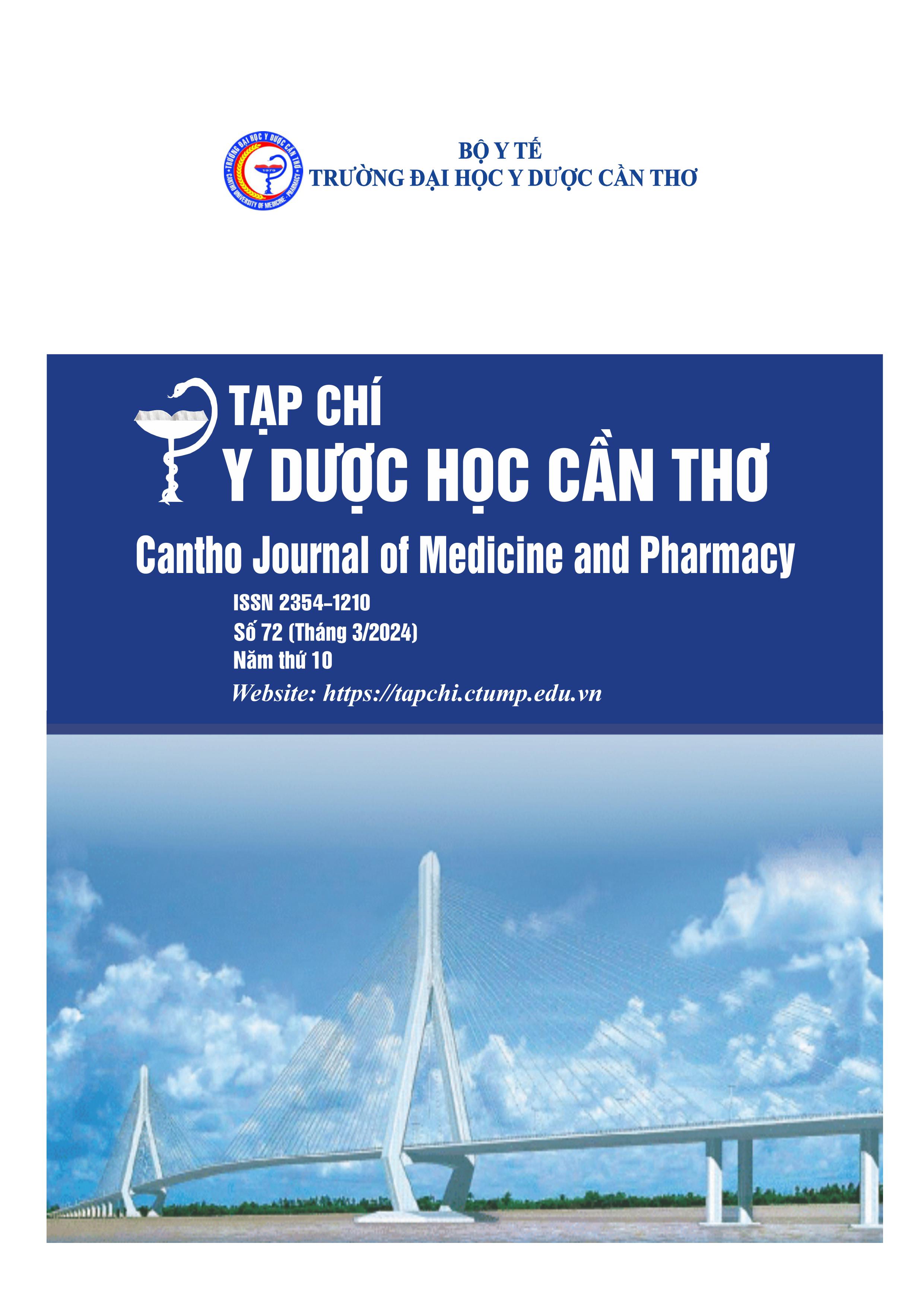CLINICAL CHARACTERISTICS, COMPLICATIONS IN PATIENTS WITH SUBARACHNOID HEMORRHAGE DUE TO RUPTURED CEREBRAL ANEURYSM
Main Article Content
Abstract
Background: Cases of non-traumatic subarachnoid hemorrhage are mostly caused by ruptured cerebral aneurysms. This is a serious disease with a high mortality rate and many dangerous complications. Objectives: To describe the clinical characteristics and complications in patients with subarachnoid hemorrhage due to ruptured cerebral aneurysm. Materials and methods: Case series study on 48 patients with subarachnoid hemorrhage due to ruptured cerebral aneurysm treated at Can Tho Central General Hospital and S.I.S Can Tho International General Hospital. Results: Clinical features usually begin at rest (79.2%), common symptoms were headache (85.4%), disturbance of consciousness (33.3%), nausea (31.3%), meningeal signs (77.1%), hemiparesis (25%). Common complications were hyponatremia (50%), intraventricular hemorrhage (45.8%), parenchymal hemorrhage (27.1%), acute ventriculomegaly (22.9%), pneumonia (16.7%). Conclusion: Subarachnoid hemorrhage due to ruptured cerebral aneurysm has diverse clinical symptoms. Many serious complications, common complications are hyponatremia, intraventricular bleeding and brain parenchymal bleeding.
Article Details
Keywords
Subarachnoid hemorrhage, ruptured cerebral aneurysm, aneurysm
References
2. Ingall T.J., Whisnant J.P., Wiebers D.O., O'Fallon W.M. Has there been a decline in subarachnoid hemorrhage mortality?. Stroke. 1989. 20(6), 718-724, https://doi.org/ 10.1161/01.str.20.6.718.
3. Stegmayr B., Eriksson M., Asplund K. Declining mortality from subarachnoid hemorrhage: changes in incidence and case fatality from 1985 through 2000. Stroke. 2004. 35(9), 2059-2063, https://doi.org/10.1161/01.STR.0000138451.07853.b6.
4. Truelsen T., Bonita R., Duncan J., Anderson N.E., Mee E. Changes in subarachnoid hemorrhage mortality, incidence, and case fatality in New Zealand between 1981-1983 and 1991-1993. Stroke. 1998. 29(11), 2298- 2303, https://doi.org/ 10.1161/01.str.29.11.2298.
5. Steiner T., Juvela S., Unterberg A., Jung C., Forsting M., et al. European Stroke Organization guidelines for the management of intracranial aneurysms and subarachnoid haemorrhage. Cerebrovasc Dis Basel Switz. 2013. 35(2), 93-112, https://doi.org/ 10.1159/000346087.
6. Nguyễn Ngọc Dương. Một số yếu tố tiên lượng và giá trị thang điểm PAASH trong dự kiến kêt cục chức năng thần kinh ở bệnh nhân xuất huyết dưới nhện do phình vỡ mạch não. Trường Đại học Y Hà Nội. 2020. 67.
7. Võ Hồng Khởi, Lê Văn Thịnh, Nguyễn Chương. Nghiên cứu đặc điểm lâm sàng, cận lâm sàng, nguyên nhân và hướng xử trí một số biến chứng của chảy máu dưới nhện. Tạp chí Thần kinh học Việt Nam. 2015. 11, 59-66. https://hoithankinhhocvietnam.com.vn/ nghien-cuu-dac-diem-lamsang-can-lam-sang-nguyen-nhan-va-huong-xu-tri-mot-bien-chung-cua-chay-mau-duoi-nhen/. 8. Vương Thị Thu Hiền. Giá trị tiên lượng của thang điểm WFNS đối với kết quả xấu sau chảy máu dưới nhện do phình động mạch não. Tạp chí nghiên cứu Y học. 2021. 149(1), 135-141, https://doi.org/10.52852/tcncyh.v149i1.516.
9. Đào Thị Thanh Nhã. Các yếu tố tiên lượng kết cục của bệnh nhân xuất huyết dưới nhện. Tạp chí Y học Việt Nam. 2019. 477(2), 46-49.
10. Saramma P., Menon R.G., Srivastava A., Sarma P.S. Hyponatremia after aneurysmal subarachnoid hemorrhage: Implications and outcomes. J Neurosci Rural Pract. 2013. 4(1), 2428, https://doi.org/10.4103/0976-3147.105605.


